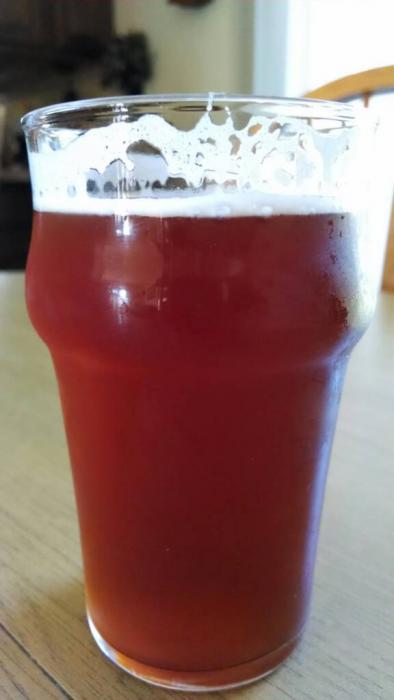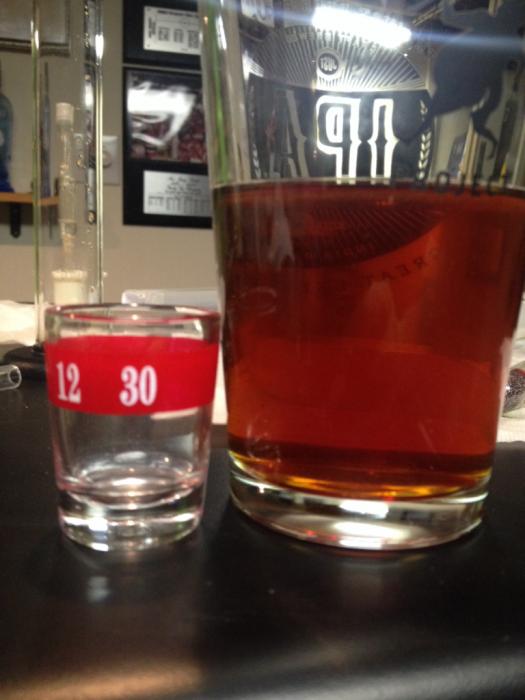Brewmex41
Well-Known Member
what kind of attenuation are you guys seeing with this malt? looks like I might finish a bit high, was aiming for 1.011, looks like actual might be 1.015. mash temp 153
84% with pacman yeast and an hour mash @150

what kind of attenuation are you guys seeing with this malt? looks like I might finish a bit high, was aiming for 1.011, looks like actual might be 1.015. mash temp 153
Just found out that my LHBS is looking to carry this stuff soon. When they do, I'm going to brew a 2-gallon SMaSH with it i think, and try to hit the 1.050 OG they recommend for color.
Not sure if I want to use any hops for flavoring, or just drop in a little Warrior for bittering (20IBU?) and leave the Malt flavor as clean as possible. If anybody has any recommendations there I'm all ears!












If I were to brew this again I would go one of two ways:
Mash super low and center the beer around the hops
Mash higher, add a little caramel malt or other specialty grain and make a delicious amber ale.
Either way, I like this malt with a little hop presence. You can use some American flavor hops, or try a German flavor hop to accentuate the German profile of this malt.
It's a little bland on its own. I shared a lot of the brew so I could keg something else.
This thread got me all excited about this stuff so I bought a bag and made a beer yesterday using the RedX at about 58% (the rest Pils, Carafoam and some sauermalz) and what a dissapointment! My son was helping me and I kept saying "Does that look unusually red to you?" and he kept saying "No." I figured that if this stuff were redder than normal it would have some effect at 58% (the LHBS only had the 1 bag so I couldn't do 100%) but it doesn't. The wort has average color! Its 11.2 SRM and the first two components of the deviation of it's spectrum from average are -0.06 and + 0.08. This wort is the closest to average (smallest spectral deviation) I have ever measured. A really red beer like a Kriek or Frambois will have those coefficients at around 1 and -1. So unless this beer turns really red in the fermenter it looks like a hoax to me.
But does it look any redder than any another beer with similar SRM?
I think that the idea is that this malt gives a reddish contribution when used in combination with other grains, and a more distinct red when used in very high proportion.
I did a 1.052 SMaSH with this that is currently cold crashing, and it is definitely nice and red. I split the batch and fermented half with Nottingham and half with a saison yeast, and the latter is quite a bit darker.
Now, I wouldn't say that my batch is an out-of-the-ordinary red (it's not firetruck, for example). But it is definitely red in the way that you expect a red ale to look.
My last thought is that there have been pretty mixed results with this malt. I wonder if, since it's relatively new, there's still an issue with consistent quality across the distribution spectrum, or even from batch to batch at the malt house. I would think they would be on top of it, but with something like this that is the first of its kind, I could see some inconsistency being possible.
In this thread I had particularly noticed the picture in No. 75. Recognizing that the photographic process, lighting in the guy's kitchen and limitations of computer displays are doubtless at play here I have never seen a beer that red, including Krieks and and Framboises. The most intensely red one of those I have ever measured gave b* of 46. The photo show b* = 54. This means that the beer in that photo, if the photo is accurate, is redder than the reddest cherry or raspberry lambic and I have trouble accepting that especially given what I observed yesterday. Does it really look redder than most Krieks and Framboises?
In the fermenter (with the starter mixed in) the wort was 13.6 °P or about 1.056. You can't really calculate color from OG or OG from color because the amount of color development varies widely depending on length of boil (2hr 15 min here), and whether decoctions were used (3 here). The fermentation will also darken the beer relative to the wort in most cases.You say that you made a beer with 58% Red-X, and you say the SRM came out to 11.2. By my calculations this must have been a very high gravity beer (~1.068 or so?).
I'm not sure if that is a factor or not, but according to BestMalz (earlier in this thread), they recommend brewing beers with 100% Red-X @ 1.050 gravity for optimal color. They don't say, but I'm assuming they're talking something in the 70-75% efficiency range for that. If the gravity is different, they recommend using Melanoiden or Pilsner malt to skew the color lighter or darker.
I'm not sure if a Red-X/Pilsner Combo at a higher gravity ~12SRM is the same. I don't know what that mechanism would be, and your expertise is much higher here than mine, but I figured I'd mention it.
In the fermenter (with the starter mixed in) the wort was 13.6 °P or about 1.056. You can't really calculate color from OG or OG from color because the amount of color development varies widely depending on length of boil (2hr 15 min here), and whether decoctions were used (3 here). The fermentation will also darken the beer relative to the wort in most cases.
You say that you made a beer with 58% Red-X, and you say the SRM came out to 11.2. By my calculations this must have been a very high gravity beer (~1.068 or so?).



Beer always looks redder in the fermenter than it does in the glass because the purity of the red color depends on the product of the thickness of the beer and its SRM rating.

Even though mine was higher gravity it still tastes great, just need to remake it with the correct proportions, doesn't taste like drop top at 9%
It shouldn't taste like Drop Top, they use 3 types of caramel malt, if special b counts, and lactose sugar. Red x is a base malt that has more malt sweetness, as opposed to caramel or honey sweetness, than most base malts or caramel malts.
I used your Drop Top recipe, only LHBS gave me more 2-row than what I asked for. Probably should have clarified
The beer I made with it is now lagering 600 mi south of here and I won't see it again until the fall. I did do a couple more scans as it was fermenting and did not find it becoming any redder than other beers made with normal malts so I'm still puzzled as to why it is called what it is. Beer seems as if it is going to be pretty tasty, though.